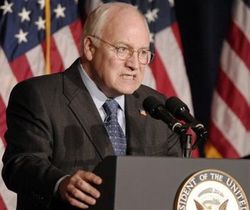mán. 25.6.2007
Cheney og pyntingapólítík bandaríkjastjórnar: línan dregin við að grafa fanga lifandi...
 Washington Post birti grein tvö í greinaflokki um "vara"forseta Bandarikjanna, Dick Cheney - og bloggarar hér vestra hafa þegar skrifað ótal færslur upp úr þessari grein, enda af nógu að taka. Samkvæmt WaPo getum við t.d. þakkað Cheney fyrir að Bandaríkin hafi ákveðið að það væri góð hugmynd að sökkva á sama ömurlega skítaplan og andstæðingarnir í röðum "íslamófasista", og pynta fanga:
Washington Post birti grein tvö í greinaflokki um "vara"forseta Bandarikjanna, Dick Cheney - og bloggarar hér vestra hafa þegar skrifað ótal færslur upp úr þessari grein, enda af nógu að taka. Samkvæmt WaPo getum við t.d. þakkað Cheney fyrir að Bandaríkin hafi ákveðið að það væri góð hugmynd að sökkva á sama ömurlega skítaplan og andstæðingarnir í röðum "íslamófasista", og pynta fanga: Shortly after the first accused terrorists reached the U.S. naval prison at Guantanamo Bay, Cuba, on Jan. 11, 2002, a delegation from CIA headquarters arrived in the Situation Room. The agency presented a delicate problem to White House counsel Alberto R. Gonzales, a man with next to no experience on the subject. Vice President Cheney's lawyer, who had a great deal of experience, sat nearby. ... "The CIA guys said, 'We're going to have some real difficulties getting actionable intelligence from detainees'" if interrogators confined themselves to humane techniques allowed by the Geneva Conventions.
From that moment, well before previous accounts have suggested, Cheney turned his attention to the practical business of crushing a captive's will to resist. The vice president's office played a central role in shattering limits on coercion of prisoners in U.S. custody, commissioning and defending legal opinions that the Bush administration has since portrayed as the initiatives, months later, of lower-ranking officials.
David S. Addington, Cheney's general counsel, set the new legal agenda in a blunt memorandum shortly after the CIA delegation returned to Langley. Geneva's "strict limits on questioning of enemy prisoners," he wrote on Jan. 25, 2002, hobbled efforts "to quickly obtain information from captured terrorists."
No longer was the vice president focused on procedural rights, such as access to lawyers and courts. The subject now was more elemental: How much suffering could U.S. personnel inflict on an enemy to make him talk? Cheney's lawyer feared that future prosecutors, with motives "difficult to predict," might bring criminal charges against interrogators or Bush administration officials.
Stjórnin komst síðan að því þeir gætu skilgreint pyntingar nokkurnveginn eins og þeim sýndist hverju sinni, og í hinu fræga "torture memo" voru pyntingar skilgreindar þannig: "equivalent in intensity" to the pain of "organ failure ..... or even death." Semsagt, Hvíta húsið vildi halda því fram að meðan fanginn er ekki beinlínis myrtur á staðnum eru það ekki pyntingar. Cheney vildi samt fá að ganga lengra:
The vice president’s lawyer advocated what was considered the memo’s most radical claim: that the president may authorize any interrogation method, even if it crosses the line of torture. U.S. and treaty laws forbidding any person to “commit torture,” that passage stated, “do not apply” to the commander in chief, because Congress “may no more regulate the President’s ability to detain and interrogate enemy combatants than it may regulate his ability to direct troop movements on the battlefield.”
Af því að forsetinn er alvaldur keisari?
That same day, Aug. 1, 2002, Yoo signed off on a second secret opinion, the contents of which have never been made public. According to a source with direct knowledge, that opinion approved as lawful a long list of specific interrogation techniques proposed by the CIA — including waterboarding, a form of near-drowning that the U.S. government classified as a war crime in 1947.
Hér eru þá lögfræðingar Hvíta Hússins beinlínis að heimila stríðsglæpi! En það er meira - málsgrein Washington Post lýkur með þessum orðum:
The opinion drew the line against one request: threatening to bury a prisoner alive.
Hugsa sér: Það eru þó einhver takmörk! Vonandi hefur Hvíta Húsið líka tekið afstöðu gegn því að fangar séu soðnir lifandi eða þeir neyddir síðan til að éta hvorn annan? Það sem er ótrúlegast er að Hvíta Húsið skuli yfirhöfuð verið að velta því fyrir sér hvort ekki væri í lagi að hóta föngum því að þeir yrðu grafnir lifandi. Það sem grein Washington Post leiðir þó í ljós er að skiptar skoðanir voru innan ríkisstjórnarinnar á ágæti þessarar villimennsku:
On June 8, 2004, national security adviser Condoleezza Rice and Secretary of State Colin L. Powell learned of the two-year-old torture memo for the first time from an article in The Washington Post. According to a former White House official with firsthand knowledge, they confronted Gonzales together in his office. Rice "very angrily said there would be no more secret opinions on international and national security law," the official said, adding that she threatened to take the matter to the president if Gonzales kept them out of the loop again. Powell remarked admiringly, as they emerged, that Rice dressed down the president's lawyer "in full Nurse Ratched mode," a reference to the ward chief of a mental hospital in the 1975 film "One Flew Over the Cuckoo's Nest." Neither of them took their objections to Cheney, the official said, a much more dangerous course.
Það þorir nefnilega enginn að confrontera Cheney - sem vilar ekki fyrir sér að skjóta vini sína í andlitið!
M
Svo bendi ég aftur á ný heimkynni Freedomfries - eyjan.is
Meginflokkur: Ríkisvald | Aukaflokkur: Stjórnmál og samfélag | Facebook


Bæta við athugasemd [Innskráning]
Ekki er lengur hægt að skrifa athugasemdir við færsluna, þar sem tímamörk á athugasemdir eru liðin.